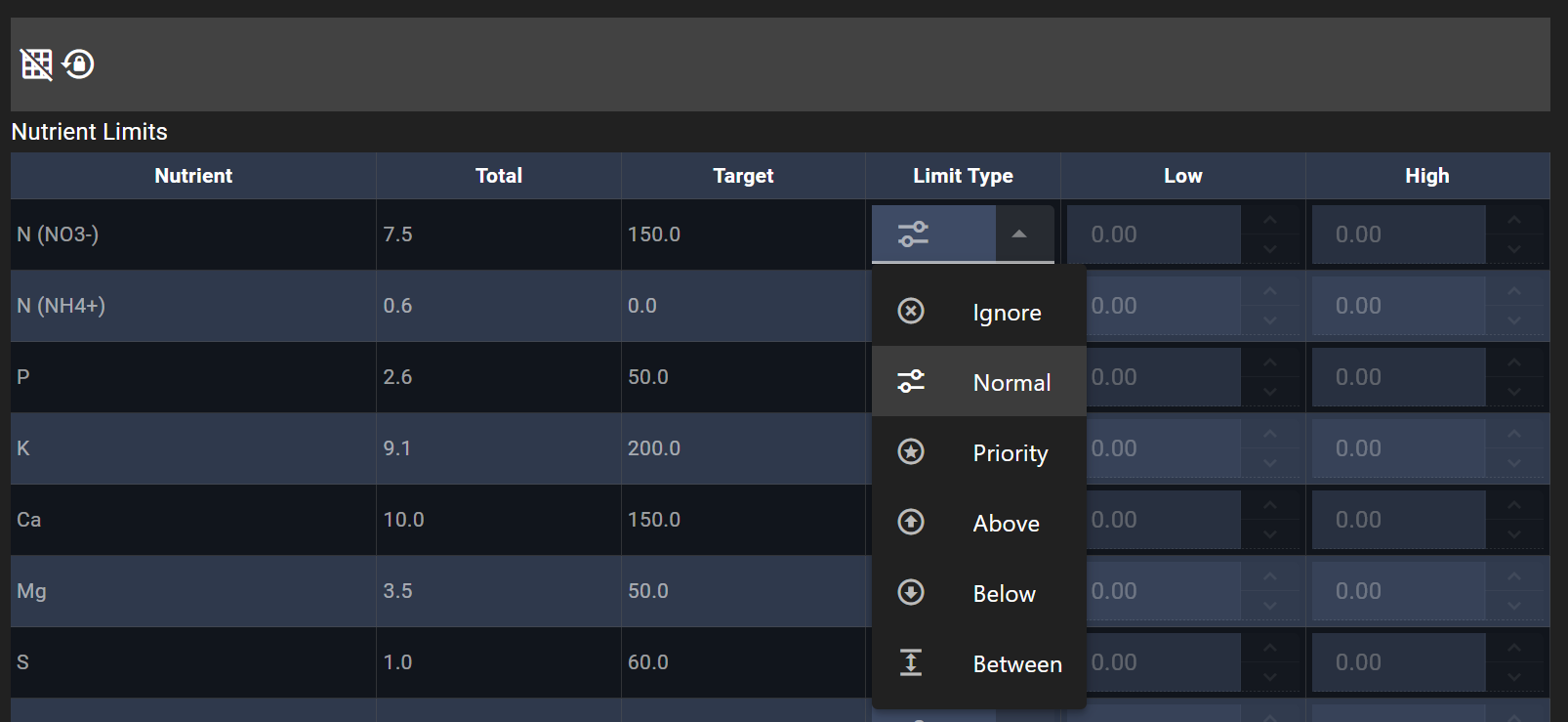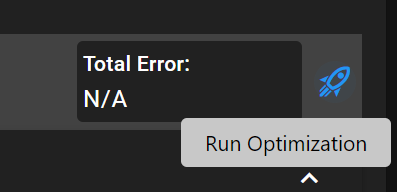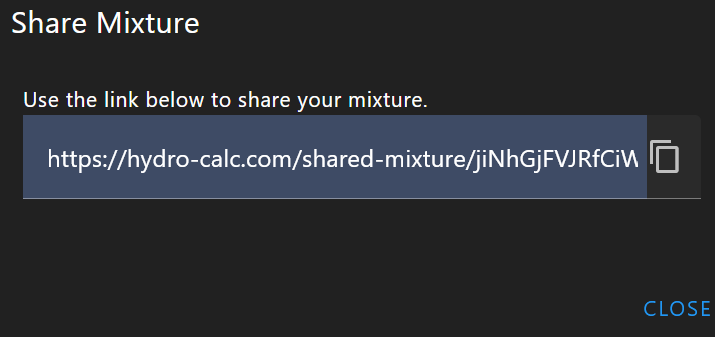Appearance
Mixtures
A Mixture is the heart of Hydro-Calc. It is a recipe that combines your Substances to achieve a specific Nutrient Target.
What does a Mixture contain?
A mixture is more than just a list of ingredients. It contains all the information needed to create a complete nutrient solution:
- Name and Description: To help you identify and organize your mixtures.
- Volume: The final volume of the nutrient solution (in Liters or Gallons).
- Water Quality Profile: The source water to use as a base.
- Nutrient Target: The desired final concentrations of nutrients.
- Substances: The list of substances to be used in the mixture, along with any constraints (e.g., limits on the amount to use).
- Solution: The results of the optimization, showing the calculated amount of each substance to use.
The Mixture Editor
The mixture editor is where you will spend most of your time when creating a new formula. It is a powerful and flexible interface that allows you to control every aspect of your mixture. The editor is divided into several sections, each with its own set of controls.
Main Toolbar
At the top of the editor, you'll find the main toolbar with the following actions:
- Save and Share: Saves the current state of your mixture and then opens a dialog to generate a shareable link.
- Save: Saves your mixture. It's good practice to save often!
- Cancel: Exits the editor without saving any changes and returns you to the previous page.
General Information
This section at the top of the editor allows you to define the basic properties of your mixture.
- Mixture Name & Description: Edit the name and add a description to keep your mixtures organized.
- Volume: Set the final volume of your nutrient solution in Liters.
- Water Quality Selector: Select a source water profile. The nutrients already present in your water will be factored into the final calculation.
- Nutrient Target Selector: Select a Nutrient Target. This is the desired final concentration of nutrients for your mixture.
- Substance Selector: Add substances from your Shelf to your mixture.
Substance Amounts
This section is for managing the substances in your mixture and their amounts. It has two sets of amounts: Amount A (your manual input) and Amount B (the optimized result).
 Toolbar Actions:
Toolbar Actions:
- Swap Amounts: Swaps all values between Amount A and Amount B.
- Copy A to B: Copies all your manually entered amounts (A) to the optimized amounts (B).
- Copy B to A: Copies all the optimized amounts (B) to your manual input column (A). This is useful if you want to use the optimized result as a new starting point for manual adjustments.
- Increase/Decrease All by %: Increases or decreases the amount of every substance in Amount A by 1% or 10%.
Individual Substance Actions:
Within the substance table, each substance has its own set of controls to:
- Remove: Deletes the substance from your mixture.
- Adjust Amount: Manually enter the amount of the substance to use (in grams per unit of volume).
- Swap, Copy A to B, Copy B to A: Perform the same copy/swap actions for a single substance.
- Adjust by %: Increase or decrease the amount for that specific substance by a percentage.
Nutrient Analysis & Chart
These panels provide a visual representation of the nutrients in your mixture based on the substance amounts you've entered.
- Nutrient Analysis: A grid showing the calculated PPM for each nutrient. It compares your current mixture's nutrient levels against your selected Nutrient Target.
- Nutrient Chart: A bar chart that visually compares the nutrient levels in Amount A and Amount B against your target.
Optimization Settings
Here, you can fine-tune the behavior of the optimization engine by setting limits.
- Reset Nutrient Limits: Removes all custom limits you've set for individual nutrients.
- Reset Substance Limits: Removes all custom limits you've set for individual substances.
- Nutrient Limits Editor: Set constraints for each nutrient (e.g., ensure Nitrogen is within a specific PPM range).
- Substance Limits Editor: Set constraints for each substance (e.g., limit the maximum amount of a specific substance to use).
Working with Limits
Limits are powerful constraints you can give the optimization engine to ensure the final recipe meets your specific requirements, whether they are chemical, practical, or cost-related.
Nutrient Limits
Nutrient limits control the final concentration (PPM) of each nutrient in the solution. The optimizer will try to minimize total ppm error against the target subject to these limits. When limits are set as bounds (such as above or below) then error is not considered but the solution must meet those requirements. You can use a tight between range to force the system to try to hit a certain target at the expense of others.

- Ignore: The optimizer will not consider this nutrient in its calculations.
- Normal: This is the default. The optimizer will try to get as close as possible to the target for this nutrient.
- Priority: The optimizer will treat this nutrient's target as more important than 'Normal' nutrients, trying harder to match the target PPM.
- Above: The final concentration must be at least the "Low" value you set.
- Below: The final concentration must be no more than the "High" value you set.
- Between: The final concentration must be within the "Low" and "High" range you specify.
Substance Limits
Substance limits control the amount of each individual substance used in the recipe. This is useful for managing inventory, avoiding solubility issues, or controlling costs.

- Normal: The optimizer is free to use any amount of this substance to reach the goal.
- Above: The amount of this substance used must be at least the "Low" value you set.
- Below: The amount of this substance used must be no more than the "High" value you set.
- Between: The amount of this substance used must be within the "Low" and "High" range you specify.
- Fixed: The amount of this substance is locked to the value you enter. The optimizer will not change it and will work around this fixed amount to solve the mixture.
Running an Optimization
- Run Optimization Button: This is the main action. Clicking this will send your mixture, target, and constraints to the optimization engine.

- Total Error: After an optimization, this field displays a score representing how close the solution is to your target. A lower number is better.
Ratios, Cost Analysis, and Mixing Recipe
These panels display additional information derived from your mixture's composition.
- Ratios: Shows how your mixture's nutrient ratios compare to your saved Ratios.
- Cost Analysis: Provides an estimated cost for your mixture based on the substance prices you've entered on your shelf.
- Mixing Recipe: A step-by-step guide on how to mix your solution based on the calculated substance amounts.
Sharing a Mixture
You can easily share your mixtures with other Hydro-Calc users. Simply click the "Share" button in the mixture editor, and you will get a unique link that you can send to others. This is great for collaborating on formulas or getting feedback from the community. Only your A values will be shared.
